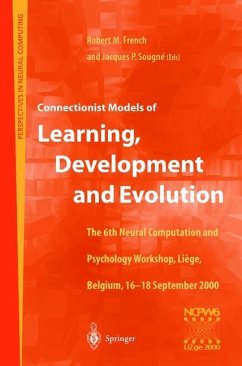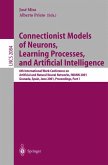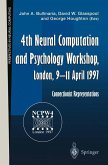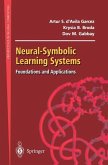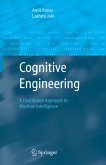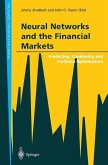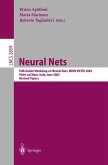Robert M. French / Jacques P. Sougne (eds.)Proceedings of the Sixth Neural Computation and Psychology Workshop, Liège, Belgium, 16-18 September 2000
Connectionist Models of Learning, Development and Evolution
Proceedings of the Sixth Neural Computation and Psychology Workshop, Liège, Belgium, 16-18 September 2000
Herausgegeben:French, Robert M.; Sougne, Jacques P.
Robert M. French / Jacques P. Sougne (eds.)Proceedings of the Sixth Neural Computation and Psychology Workshop, Liège, Belgium, 16-18 September 2000
Connectionist Models of Learning, Development and Evolution
Proceedings of the Sixth Neural Computation and Psychology Workshop, Liège, Belgium, 16-18 September 2000
Herausgegeben:French, Robert M.; Sougne, Jacques P.
- Broschiertes Buch
- Merkliste
- Auf die Merkliste
- Bewerten Bewerten
- Teilen
- Produkt teilen
- Produkterinnerung
- Produkterinnerung
Connectionist Models of Learning, Development and Evolution comprises a selection of papers presented at the Sixth Neural Computation and Psychology Workshop - the only international workshop devoted to connectionist models of psychological phenomena. With a main theme of neural network modelling in the areas of evolution, learning, and development, the papers are organized into six sections: The neural basis of cognition Development and category learning Implicit learning Social cognition Evolution Semantics Covering artificial intelligence, mathematics, psychology, neurobiology, and…mehr
Andere Kunden interessierten sich auch für
![Connectionist Models of Neurons, Learning Processes, and Artificial Intelligence Connectionist Models of Neurons, Learning Processes, and Artificial Intelligence]() Jose Mira / Alberto Prieto (eds.)Connectionist Models of Neurons, Learning Processes, and Artificial Intelligence78,99 €
Jose Mira / Alberto Prieto (eds.)Connectionist Models of Neurons, Learning Processes, and Artificial Intelligence78,99 €![4th Neural Computation and Psychology Workshop, London, 9-11 April 1997 4th Neural Computation and Psychology Workshop, London, 9-11 April 1997]() 4th Neural Computation and Psychology Workshop, London, 9-11 April 199739,99 €
4th Neural Computation and Psychology Workshop, London, 9-11 April 199739,99 €![Neural-Symbolic Learning Systems Neural-Symbolic Learning Systems]() Artur S. d'Avila GarcezNeural-Symbolic Learning Systems115,99 €
Artur S. d'Avila GarcezNeural-Symbolic Learning Systems115,99 €![Cognitive Engineering Cognitive Engineering]() Amit KonarCognitive Engineering113,99 €
Amit KonarCognitive Engineering113,99 €![Neural Networks and the Financial Markets Neural Networks and the Financial Markets]() Jimmy ShadboltNeural Networks and the Financial Markets115,99 €
Jimmy ShadboltNeural Networks and the Financial Markets115,99 €![Communication from an Artificial Intelligence Perspective Communication from an Artificial Intelligence Perspective]() OrtonyCommunication from an Artificial Intelligence Perspective115,99 €
OrtonyCommunication from an Artificial Intelligence Perspective115,99 €![Neural Nets Neural Nets]() Bruno Apolloni / Maria Marinaro / Roberto Tagliaferri (eds.)Neural Nets39,99 €
Bruno Apolloni / Maria Marinaro / Roberto Tagliaferri (eds.)Neural Nets39,99 €-
-
-
Connectionist Models of Learning, Development and Evolution comprises a selection of papers presented at the Sixth Neural Computation and Psychology Workshop - the only international workshop devoted to connectionist models of psychological phenomena.
With a main theme of neural network modelling in the areas of evolution, learning, and development, the papers are organized into six sections:
The neural basis of cognition
Development and category learning
Implicit learning
Social cognition Evolution
Semantics
Covering artificial intelligence, mathematics, psychology, neurobiology, and philosophy, it will be an invaluable reference work for researchers and students working on connectionist modelling in computer science and psychology, or in any area related to cognitive science.
With a main theme of neural network modelling in the areas of evolution, learning, and development, the papers are organized into six sections:
The neural basis of cognition
Development and category learning
Implicit learning
Social cognition Evolution
Semantics
Covering artificial intelligence, mathematics, psychology, neurobiology, and philosophy, it will be an invaluable reference work for researchers and students working on connectionist modelling in computer science and psychology, or in any area related to cognitive science.
Produktdetails
- Produktdetails
- Perspectives in Neural Computing
- Verlag: Springer / Springer London / Springer, Berlin
- Artikelnr. des Verlages: 978-1-85233-354-6
- Softcover reprint of the original 1st edition 2001
- Seitenzahl: 340
- Erscheinungstermin: 23. März 2001
- Englisch
- Abmessung: 235mm x 155mm x 19mm
- Gewicht: 520g
- ISBN-13: 9781852333546
- ISBN-10: 1852333545
- Artikelnr.: 21461880
- Herstellerkennzeichnung
- Springer-Verlag GmbH
- Tiergartenstr. 17
- 69121 Heidelberg
- ProductSafety@springernature.com
- Perspectives in Neural Computing
- Verlag: Springer / Springer London / Springer, Berlin
- Artikelnr. des Verlages: 978-1-85233-354-6
- Softcover reprint of the original 1st edition 2001
- Seitenzahl: 340
- Erscheinungstermin: 23. März 2001
- Englisch
- Abmessung: 235mm x 155mm x 19mm
- Gewicht: 520g
- ISBN-13: 9781852333546
- ISBN-10: 1852333545
- Artikelnr.: 21461880
- Herstellerkennzeichnung
- Springer-Verlag GmbH
- Tiergartenstr. 17
- 69121 Heidelberg
- ProductSafety@springernature.com
SECTION I: Neural Basis of Cognition.- 1. Applying Neuroanatomical Distinctions to Connectionist Cognitive Modelling.- 2. Pseudopatterns and Dual-Network Memory Models: Advantages and Shortcomings.- 3. A Learning Algorithm for Synfue Chains.- 4. Towards a Spatio-Temporal Analysis Tool for fMRI Data: An Application to Depth-from-Motion Processing in Humans.- 5. A Simple Model Exhtbiting Scalar Timing.- 6. Modularity and Specialized Learning in the Organization of Behaviour.- 7. Modeling Modulatory Aspects in Association Processes.- 8. Recognition of Novelty Made Easy: Constraints of Channel Capacity on Generative Networks.- 9. A Biologically Plausible Maturation of an ART Network.- SECTION II: Development and Category Learning.- 10. Developing Knowledge about Living Things: A Connectionist Investigation.- 11. Paying Attention to Relevant Dimensions: A Localist Approach.- 12. Coordinating Multiple Sensory Modalities While Learning to Reach.- 13. Modelling Cognitive Development with Constructivist Neural Networks.- 14. Learning Action Affordances and Action Schemas.- 15. A Three-Layer Configural Cue Model ofCategory Learning Rates.- 16. A Revival of Turing's Forgotten Connectionist Ideas: Exploring Unorganized Machines.- 17. Visual Crowding and Category-Specific Deficits: A Neural Network Model.- SECTION III: Implicit Learning.- 18.Implicit Learning of Regularities in Western Tonal Music by Self-Organization.- 19. Rules vs. Statistics in Implicit Learning of Biconditional Grammars.- 20. Hidden Markov Model Interpretations of Neural Networks.- SECTION IV: Models of Social Cognition.- 21. A Connectionist Model of Person Perception and Stereotype Formation.- 22. Learning about an Absent Cause: Discounting and Augmentation of Positively and Independently Related Causes.-SECTION V: Evolution.- 23. Exploring the Baldwin Effect in Evolving Adaptable Control Systems.- 24. Borrowing Dynamies from Evolution: Association using Catalytie Network Models.- 25. Evolving Modular Architectures for Neural Networks.- 26. Evolution, Development and Learning - A Nested Hierarchy?.- SECTION VI: Semantics.- 27. Learning Lexical Properties from Word Usage Patterns: Which Context Words Should be Used?.- 28. Associative Computation and Associative Prediction.- 29. The Development of Small-World Semantie Networks.- 30. What is the Dimensionality of Human Semantie Space?.- Author Index.
SECTION I: Neural Basis of Cognition.- 1. Applying Neuroanatomical Distinctions to Connectionist Cognitive Modelling.- 2. Pseudopatterns and Dual-Network Memory Models: Advantages and Shortcomings.- 3. A Learning Algorithm for Synfue Chains.- 4. Towards a Spatio-Temporal Analysis Tool for fMRI Data: An Application to Depth-from-Motion Processing in Humans.- 5. A Simple Model Exhtbiting Scalar Timing.- 6. Modularity and Specialized Learning in the Organization of Behaviour.- 7. Modeling Modulatory Aspects in Association Processes.- 8. Recognition of Novelty Made Easy: Constraints of Channel Capacity on Generative Networks.- 9. A Biologically Plausible Maturation of an ART Network.- SECTION II: Development and Category Learning.- 10. Developing Knowledge about Living Things: A Connectionist Investigation.- 11. Paying Attention to Relevant Dimensions: A Localist Approach.- 12. Coordinating Multiple Sensory Modalities While Learning to Reach.- 13. Modelling Cognitive Development with Constructivist Neural Networks.- 14. Learning Action Affordances and Action Schemas.- 15. A Three-Layer Configural Cue Model ofCategory Learning Rates.- 16. A Revival of Turing's Forgotten Connectionist Ideas: Exploring Unorganized Machines.- 17. Visual Crowding and Category-Specific Deficits: A Neural Network Model.- SECTION III: Implicit Learning.- 18.Implicit Learning of Regularities in Western Tonal Music by Self-Organization.- 19. Rules vs. Statistics in Implicit Learning of Biconditional Grammars.- 20. Hidden Markov Model Interpretations of Neural Networks.- SECTION IV: Models of Social Cognition.- 21. A Connectionist Model of Person Perception and Stereotype Formation.- 22. Learning about an Absent Cause: Discounting and Augmentation of Positively and Independently Related Causes.-SECTION V: Evolution.- 23. Exploring the Baldwin Effect in Evolving Adaptable Control Systems.- 24. Borrowing Dynamies from Evolution: Association using Catalytie Network Models.- 25. Evolving Modular Architectures for Neural Networks.- 26. Evolution, Development and Learning - A Nested Hierarchy?.- SECTION VI: Semantics.- 27. Learning Lexical Properties from Word Usage Patterns: Which Context Words Should be Used?.- 28. Associative Computation and Associative Prediction.- 29. The Development of Small-World Semantie Networks.- 30. What is the Dimensionality of Human Semantie Space?.- Author Index.

